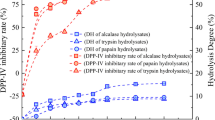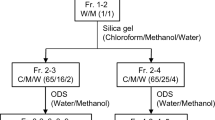Abstract
Dipeptidyl peptidase IV (DPP-IV) inhibitors have become a new choice to treat diabetes. Here, we studied the DPP-IV inhibitory activity of protein hydrolysates from common carp (Cyprinus carpio) roe. The molecular weight distribution and simulated gastrointestinal digestive stability of hydrolysates produced by four enzymes were analyzed. Papain-generated hydrolysate showed the highest DPP-IV inhibition and effective gastrointestinal stability. New effective peptide sequences from papain hydrolysates were identified using liquid chromatography-tandem mass spectrometry. The bioactivity of IPNVAVD, which was identified from papain hydrolysate (IC50 value of 777.35 ± 5.50 μM), was investigated by Caco-2 and HepG2 cell models. We found that the DPP-IV inhibition by papain hydrolysate was not attenuated after simulated gastrointestinal digestion. In addition, IPNVAVD significantly inhibited the DPP-IV secreted by Caco-2 cells with no cytotoxicity. It also promoted glucose uptake in insulin-resistant HepG2 cells. Transport experiments showed that IPNVAVD could be absorbed intactly by the Caco-2 cell monolayer. Protein hydrolysates from common carp roe inhibited DPP-IV effectively, and they may have potential as functional ingredients in food for diabetic patients.





Similar content being viewed by others
References
Wing RR, Lang W, Wadden TA, Safford M, Knowler WC, Bertoni AG, Hill JO, Brancati FL, Peters A, Wagenknecht L, Look ARG (2011) Benefits of modest weight loss in improving cardiovascular risk factors in overweight and obese individuals with type 2 diabetes. Diabetes Care 34(7):1481–1486
Carracher AM, Marathe PH, Close KL (2018) International diabetes federation 2017. J Diabetes 10(5):353–356
Okada S, Hiuge A, Makino H, Nagumo A, Takaki H, Konishi H, Goto Y, Yoshimasa Y, Miyamoto Y (2010) Effect of exercise intervention on endothelial function and incidence of cardiovascular disease in patients with type 2 diabetes. J Atheroscler Thromb 17(8):828–833
Imamura F, O’Connor L, Ye Z, Mursu J, Hayashino Y, Bhupathiraju SN, Forouhi NG (2016) Consumption of sugar sweetened beverages, artificially sweetened beverages, and fruit juice and incidence of type 2 diabetes: systematic review, meta-analysis, and estimation of population attributable fraction. Brit J Sport Med 50(8):496-U484
Filozof C, Gautier JF (2010) A comparison of efficacy and safety of vildagliptin and gliclazide in combination with metformin in patients with Type 2 diabetes inadequately controlled with metformin alone: a 52-week, randomized study. Diabetic Med 27(3):318–326
Nongonierma AB, FitzGerald RJ (2014) An in silico model to predict the potential of dietary proteins as sources of dipeptidyl peptidase IV (DPP-IV) inhibitory peptides. Food Chem 165:489–498
Harnedy PA, O’Keeffe MB, FitzGerald RJ (2015) Purification and identification of dipeptidyl peptidase (DPP) IV inhibitory peptides from the macroalga Palmaria palmata. Food Chem 172:400–406
Zhang Y, Liu H, Hong H, Luo Y (2019) Purification and identification of dipeptidyl peptidase iv and angiotensin-converting enzyme inhibitory peptides from silver carp (hypophthalmichthys molitrix) muscle hydrolysate. Eur Food Res Technol 245(1):243–255
Kahn SE (2007) Glycemic durability of rosiglitazone, metformin, or glyburide monotherapy (vol 355, pg 2427, 2006). New Engl J Med 356(13):1387–1388
Nongonierma AB, FitzGerald RJ (2013) Dipeptidyl peptidase IV inhibitory properties of a whey protein hydrolysate: influence of fractionation, stability to simulated gastrointestinal digestion and food-drug interaction. Int Dairy J 32(1):33–39
Lacroix IME, Chen X-M, Kitts DD, Li-Chan ECY (2017) Investigation into the bioavailability of milk protein-derived peptides with dipeptidylpeptidase IV inhibitory activity using Caco-2 cell monolayers. Food Funct 8(2):701–709
Pooja K, Rani S, Kanwate B, Pal GK (2017) Physico-chemical, sensory and toxicity characteristics of dipeptidyl peptidase-IV inhibitory peptides from rice bran-derived globulin using computational approaches. Int J Pept Res Ther 23(4):519–529
Velarde-Salcedo AJ, Barrera-Pacheco A, Lara-Gonzalez S, Montero-Moran GM, Diaz-Gois A, Gonzalez de Mejia E, Barba de la Rosa AP (2013) In vitro inhibition of dipeptidyl peptidase IV by peptides derived from the hydrolysis of amaranth (Amaranthus hypochondriacus L.) proteins. Food Chem 136(2):758–764
Zhang C, Zhang Y, Wang Z, Chen S, Luo Y (2017) Production and identification of antioxidant and angiotensin-converting enzyme inhibition and dipeptidyl peptidase IV inhibitory peptides from bighead carp (Hypophthalmichthys nobilis) muscle hydrolysate. J Funct Foods 35:224–235
Zhang Y, Chen R, Chen X, Zeng Z, Ma H, Chen S (2016) Dipeptidyl peptidase IV-inhibitory peptides derived from silver carp (Hypophthalmichthys molitrix Val) Proteins. J Agric Food Chem 64(4):831–839
Li-Chan ECY, Hunag S-L, Jao C-L, Ho K-P, Hsu K-C (2012) Peptides derived from atlantic salmon skin gelatin as dipeptidyl-peptidase IV inhibitors. J Agric Food Chem 60(4):973–978
Chalamaiah M, Hemalatha R, Jyothirmayi T, Diwan PV, Bhaskarachary K, Vajreswari A, Kumar RR, Kumar BD (2015) Chemical composition and immunomodulatory effects of enzymatic protein hydrolysates from common carp (Cyprinus carpio) egg. Nutrition 31(2):388–398
FAO (2017) FAO-yearbook of fishery statistics: aquaculture production. Food and Agriculture Organization of the United Nations, Rome, p 30
Falch E, Rustad T, Jonsdottir R, Shaw NB, Dumay J, Berge JP, Arason S, Kerry JP, Sandbakk M, Aursand M (2006) Geographical and seasonal differences in lipid composition and relative weight of by-products from gadiform species. J Food Compos Anal 19(6–7):727–736
Chalamaiah M, Kumar BD, Hemalatha R, Jyothirmayi T (2012) Fish protein hydrolysates: proximate composition, amino acid composition, antioxidant activities and applications: a review. Food Chem 135(4):3020–3038
Intarasirisawat R, Benjakul S, Wu J, Visessanguan W (2013) Isolation of antioxidative and ACE inhibitory peptides from protein hydrolysate of skipjack (Katsuwana pelamis) roe. J Funct Foods 5(4):1854–1862
Intarasirisawat R, Benjakul S, Visessanguan W, Wu J (2012) Antioxidative and functional properties of protein hydrolysate from defatted skipjack (Katsuwonous pelamis) roe. Food Chem 135(4):3039–3048
Xie N, Liu S, Wang C, Li B (2014) Stability of casein antioxidant peptide fractions during in vitro digestion/Caco-2 cell model: characteristics of the resistant peptides. Eur Food Res Technol 239(4):577–586
Dimitrov I, Bangov I, Flower DR, Doytchinova I (2014) AllerTOP vol 2-a server for in silico prediction of allergens. J Mol Model 20:2278
Gupta S, Kapoor P, Chaudhary K, Gautam A, Kumar R, Raghava GPS, Open Source Drug D (2013) In Silico approach for predicting toxicity of peptides and proteins. PLoS One 8(9):e73957
Cheung IWY, Cheung LKY, Tan NY, Li-Chan ECY (2012) The role of molecular size in antioxidant activity of peptide fractions from Pacific hake (Merluccius productus) hydrolysates. Food Chem 134(3):1297–1306
Lafarga T, Wilm M, Wynne K, Hayes M (2016) Bioactive hydrolysates from bovine blood globulins: generation, characterisation, and in silico prediction of toxicity and allergenicity. J Funct Foods 24:142–155
Chi C-F, Wang B, Wang Y-M, Zhang B, Deng S-G (2015) Isolation and characterization of three antioxidant peptides from protein hydrolysate of bluefin leatherjacket (Navodon septentrionalis) heads. J Funct Foods 12:1–10
Lapsongphon N, Yongsawatdigul J (2013) Production and purification of antioxidant peptides from a mungbean meal hydrolysate by Virgibacillus sp SK37 proteinase. Food Chem 141(2):992–999
Lorey S, Stockel-Maschek A, Faust J, Brandt W, Stiebitz B, Gorrell MD, Kahne T, Mrestani-Klaus C, Wrenger S, Reinhold D, Ansorge S, Neubert K (2003) Different modes of dipeptidyl peptidase IV (CD26) inhibition by oligopeptides derived from the N-terminus of HIV-1 Tat indicate at least two inhibitor binding sites. Eur J Biochem 270(10):2147–2156
Engel M, Hoffmann T, Wagner L, Wermann M, Heiser U, Kiefersauer R, Huber R, Bode W, Demuth HU, Brandstetter H (2003) The crystal structure of dipeptidyl peptidase IV(CD26) reveals its functional regulation and enzymatic mechanism. P Natl Acad Sci USA 100(9):5063–5068
Lacroix IME, Li-Chan ECY (2014) Isolation and characterization of peptides with dipeptidyl peptidase-IV inhibitory activity from pepsin-treated bovine whey proteins. Peptides 54:39–48
Kanduc D (2008) Correlating low-similarity peptide sequences and allergenic epitopes. Curr Pharm Design 14(3):289–295
Van Hoeyveld EM, Escalona-Monge M, De Swert LFA, Stevens EAM (1998) Allergenic and antigenic activity of peptide fragments in a whey hydrolysate formula. Clin Exp Allergy 28(9):1131–1137
Caron J, Domenger D, Dhulster P, Ravallec R, Cudennec B (2017) Using Caco-2 cells as novel identification tool for food-derived DPP-IV inhibitors. Food Res Int 92:113–118
Zhang C, Liu H, Chen S, Luo Y (2018) Evaluating the effects of IADHFL on inhibiting DPP-IV activity and expression in Caco-2 cells and contributing to the amount of insulin released from INS-1 cells in vitro. Food Funct 9(4):2240–2250
Huang Q, Chen L, Teng H, Song H, Wu X, Xu M (2015) Phenolic compounds ameliorate the glucose uptake in HepG2 cells’ insulin resistance via activating AMPK Anti-diabetic effect of phenolic compounds in HepG2 cells. J Funct Foods 19:487–494
Song J-j, Wang Q, Du M, Chen B, Mao X-y (2017) Peptide IPPKKNQDKTE ameliorates insulin resistance in HepG2 cells via blocking ROS-mediated MAPK signaling. J Funct Foods 31:287–294
Howell S, Kenny AJ, Turner AJ (1992) A Survey of membrane peptidases in 2 human colonic cell-lines, Caco-2 and HT-29. Biochem J 284:595–601
Ding L, Wang L, Zhang Y, Liu J (2015) Transport of antihypertensive peptide RVPSL, ovotransferrin 328-332, in human intestinal Caco-2 cell monolayers. J Agric Food Chem 63(37):8143–8150
Acknowledgements
This study was supported by the National Key R&D Program of China (award number 2017YFD0400201) and Earmarked Fund for China Agriculture Research System (CARS-45).
Author information
Authors and Affiliations
Corresponding author
Ethics declarations
Conflict of interest
All authors declare that they have no conflict of interest.
Research involving human and/or animal participants
The research did not include any human subjects and animal experiments.
Compliance with ethics requirement
The entire experimental procedure was in accordance with the Guidance on Treating Experimental Animals developed by China’s Ministry of Science & Technology in 2006 and Regulations issued by China State Council in 1988.
Additional information
Publisher's Note
Springer Nature remains neutral with regard to jurisdictional claims in published maps and institutional affiliations.
Rights and permissions
About this article
Cite this article
Zhang, C., Gao, S., Zhang, C. et al. Evaluating in vitro dipeptidyl peptidase IV inhibition by peptides from common carp (Cyprinus carpio) roe in cell culture models. Eur Food Res Technol 246, 179–191 (2020). https://doi.org/10.1007/s00217-019-03399-6
Received:
Accepted:
Published:
Issue Date:
DOI: https://doi.org/10.1007/s00217-019-03399-6




